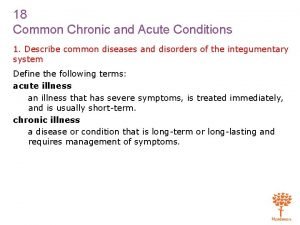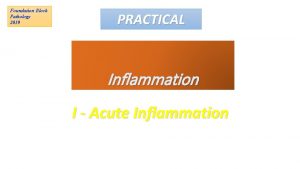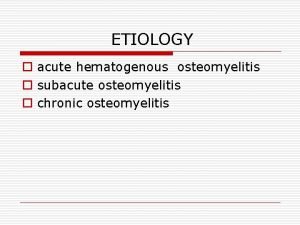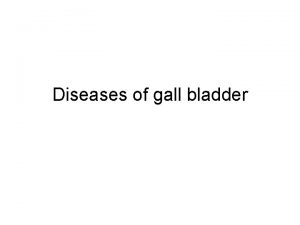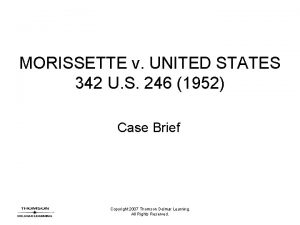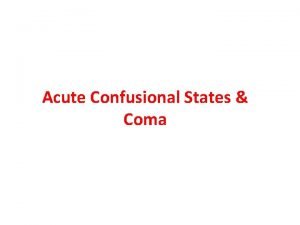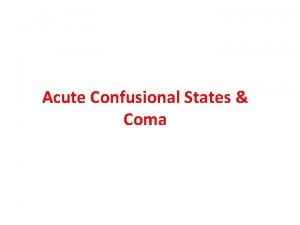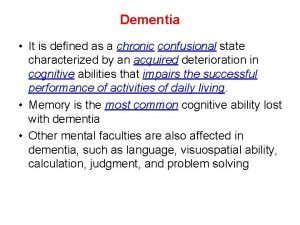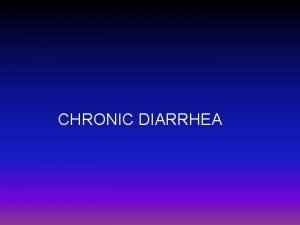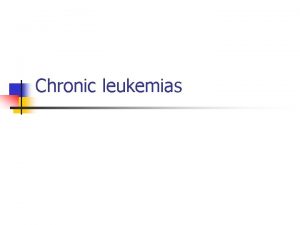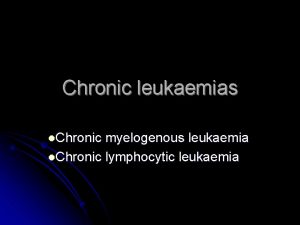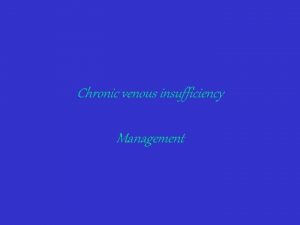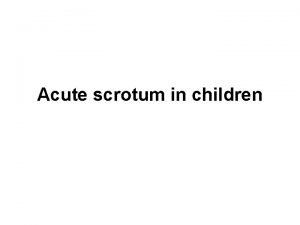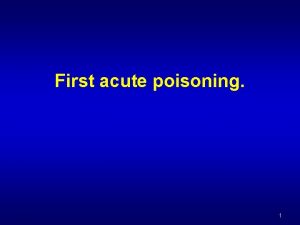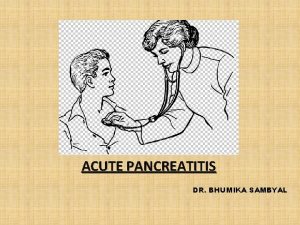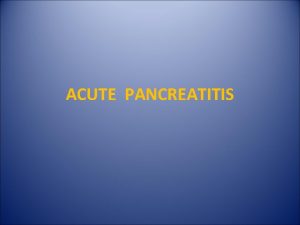Case and Discussion Chronic and Acute Confusional States






















- Slides: 22

Case and Discussion: Chronic and Acute Confusional States Connie Chen, MD Neurology Consultants of Dallas

Overview n Case presentation n Differential diagnosis n Clinical approach n Results and findings n Follow-up n Discussion

Case Presentation n 61 yo woman – episode of presyncope – “wobbly” when standing – “slow thinking” over 6 months – noted after administration of BP meds (SBP 200’s lowered to 120’s) n NRO exam non-focal. MS not extensively tested, some memory loss noted n Hyponatremic: Na=117

Case Continued n Diuretic stopped n BP raised slightly n PT d/c’d to home after Na normalized

Case Continued n 2 weeks later – Episodic worsening of confusion – Lost while driving – Worsening short-term memory – Episodes of paranoia – New delusions: § CT scanner trying to transport her to the future § Aliens trying to abduct daughter § After watching “Manchurian Candidate, ” she was also involved in a conspiracy

Case Continued n NRO exam: – MS: § Poor memory, attention, not oriented § Labile affect § Intact calculations, language § Delusional – CN, motor, sensation, cerebellar, and gait are normal

Differential diagnosis: Chronic confusional state n Progressive decline of memory, cognition: – Degenerative dementias – Multi-infarct dementia – Chronic infection (TB meningitis, syphilis, HIV) – Hypothyroidism – Vitamin deficiencies (B 12, thiamine) – Toxins – Other: seizures, neoplastic, paraneoplastic, “pseudo-dementia”

Differential diagnosis: Acute confusional state n Delirium – “Metabolic states”: § Medications/drugs § Endocrine: thyroid, glucose, hyper/hypoadrenalism § Electrolytes: Na, Ca § Vitamins: B 12, thiamine § Organ failure: liver, renal (uremia, “dialysis disequilibrium”), respiratory failure (hypoxia)

Acute Confusional State – Cerebrovascular: § stroke/TIA § hypertensive encephalopathy, hypotension § DIC, TTP – Infectious: meningitis – Seizures – Head trauma – Neoplasm – Other: (Systemic disease: rheumatologic, paraneoplastic)

Clinical approach n Systematic approach n Indications for studies n Don’t stop with one diagnosis: – “Think outside the box” – “What am I missing? ” – Tailor your work-up, you can always expand later

Our case: Results and Findings n Chronic confusional state (>6 month decline) – Degenerative dementias: § Diagnosis of exclusion § Requires memory loss in addition to another “cognitive sphere” with functional decline – Multi-infarct dementia: no evidence of infarction. – Chronic infection: LP negative ( mild protein elevation), RPR negative, HIV negative. – Hypothyroidism: nl TSH – Vitamin deficiencies (B 12, thiamine): low B 12, normal homocysteine – Toxins: negative tox screen

Results Continued n Acute confusional state: – Metabolic: § Meds: none § Endocrine: TSH normal, normo-glycemia § Infections: LP negative except elevated protein, RPR negative, HIV negative. § Vitamins: B 12 low but homocysteine normal (MMA pending), thiamine given. § Electrolytes: Na 131, dropped to 127. § Organ failure: organs normal, no respiratory failure.

Results Continued § Cerebrovascular: no focality to suggest stroke/TIA, not hyper or hypotensive, no evidence DIC/TTP. § Seizure: left temporal sharp wave. No seizure. § Neoplasm: normal head CT.

What else am I missing? n Delirium with new onset pyschosis : – Antiphospholipid antibody syndrome – Limbic encephalitis (paraneoplastic syndrome) – Porphyria

More Results n ESR, ANA, anticardiolipin antibodies negative.

More Results n Chest CT: – right paratracheal node – 0. 8 cm nodular opacity right upper lobe. n Biopsy of node: small cell lung cancer.

Follow-up n Treatment with XRT and CMTx. n Psychotic symptoms resolved. n Memory loss remains.

Discussion n Limbic encephalitis: “a paraneoplastic syndrome marked by degeneration of neurons in the medial temporal lobe. ”

Limbic encephalitis – Incidence: unknown (rare) – Symptoms: § Acute confusional states § Memory loss § Seizures § “Psychiatric” symptoms § Dementia – Antineuronal antibodies: anti-Hu, anti-Ta, (anti-Ma, others)

Limbic encephalitis – Often presents before tumor diagnosis – Tumor associations § Lung (small cell, non-small cell) § Testicular § Breast

Limbic encephalitis: Studies n EEG: temporal lobe seizures, sharp waves, normal. n CSF: (can be normal) § Mild pleocytosis § Mildly elevated protein n Radiographic: – MRI: (can be normal) § medial temporal lobe: “bright” on T 2, enhances with contrast. § brainstem § hypothalamus – ** r/o HSV encephalitis**

Limbic encephalitis: Treatment: underlying tumor n Immune modulatory treatments attempted: n – – Steroids Cyclophosphamide IV IG Plasmapheresis n Improvement of symptoms only with tumor treatment n If diagnosed- search for tumor!
 Cellular events of acute inflammation
Cellular events of acute inflammation Chapter 18 common chronic and acute conditions
Chapter 18 common chronic and acute conditions Acute inflammation
Acute inflammation Leukemia survival rate
Leukemia survival rate Classification of periapical diseases
Classification of periapical diseases Acute cholecystitis vs chronic cholecystitis
Acute cholecystitis vs chronic cholecystitis Acute subacute chronic
Acute subacute chronic Acute cholecystitis vs chronic cholecystitis
Acute cholecystitis vs chronic cholecystitis Acute vs chronic heart failure
Acute vs chronic heart failure Best case worst case average case
Best case worst case average case Simple distillation discussion
Simple distillation discussion Malnutrition case study example
Malnutrition case study example 11 free states
11 free states Map of northern united states
Map of northern united states Tyranny
Tyranny Case based discussion template nhs
Case based discussion template nhs Morissette v. united states case brief
Morissette v. united states case brief Short case vs long case
Short case vs long case Binary search time complexity worst case
Binary search time complexity worst case Bubble sort best case and worst case
Bubble sort best case and worst case Bubble sort best case and worst case
Bubble sort best case and worst case Bubble sort best case and worst case
Bubble sort best case and worst case The ambiguous case
The ambiguous case

